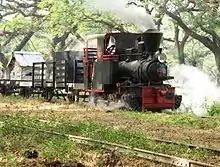Cepu Forest Railway
The Cepu Forest Railway (officially branded as Loco Tour Cepu) is a 1,067 mm (3 ft 6 in) narrow gauge light logging railway that runs through teak plantations to the northwest of the town of Cepu, in Cepu district, on the boundary between Central and East Java provinces, on the island of Java in Indonesia. It is owned by Perhutani, a state-owned forestry company of Indonesia. Steam traction is still dominant.


Along with Olean Sugar Mill in Situbondo, East Java (a candidate World Heritage Site[1]), Tasik Madu sugar mill and the rack railway at Ambarawa (both also in Central Java), the Cepu Forest Railway is one of the four main centres of steam railway heritage remaining in Java. In fact, with four operable steam locomotives, built by Berliner Maschinenbau and Du Croo & Brauns,[2] the Cepu depot has the largest concentration of active preserved steam locomotives in Indonesia. It is therefore of major heritage importance and due to its globally significant status as an active and complete steam locomotive-powered logging railway it might also be considered a candidate World Heritage Site.

The railway was originally constructed circa 1915 and was fully operational until the late 1990s, with over 300 kilometres (190 mi) of track in the Perhutani forests. Since 1998 much of the track has been lifted, but occasional logging trains continued to operate until 2002.
Since 2002 only chartered logging trains and a tourist train have been run (Loko Tour). The railway is popular with foreign tourists, especially from Europe, the United States and Japan. The main remaining line is of a distance of around 30 kilometres (19 mi) to an arboretum where there are spectacular 150-year-old teak trees along with a visitor centre where tourist train passengers are often entertained by local cultural shows.
In 2006 a bridge just outside Cepu was damaged by flooding. In late 2007 this was repaired, and tourist trains were restored to the arboretum in December 2007. Since then there have been numerous tours and chartered logging trains. There were also reportedly 'real' logging trains run early in 2010 when otherwise inaccessible trees brought down by storm damage were removed using steam trains.
Tours and charter trains are marketed and run by PT Palawi, a subsidiary of Perhutani, in Jakarta.[3]
References
- Dickinson, Rob and Yuehong. "Olean Sugar Mill - a candidate for a World Heritage Site?". The International Steam Pages. Retrieved December 18, 2008.
- http://www.internationalsteam.co.uk/trains/cepu.htm
- "Archived copy". Archived from the original on 2010-08-21. Retrieved 2010-07-31.CS1 maint: archived copy as title (link)
Further reading
Sujayanto, G. (2001). "It's a Nice Day bersama Loko Tua". Intisari. September 2001: 34–35.
